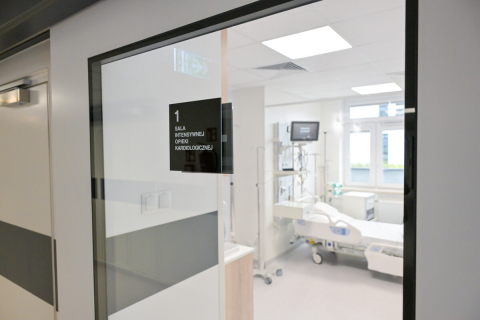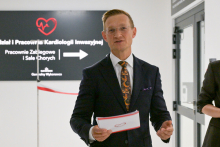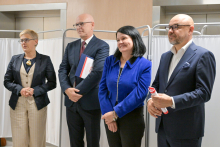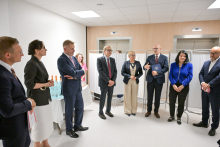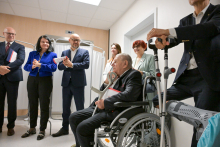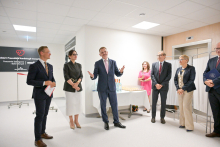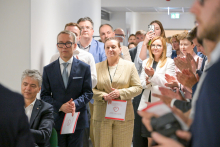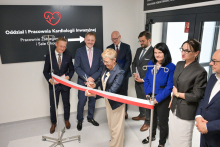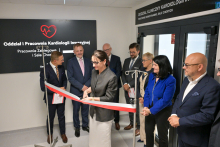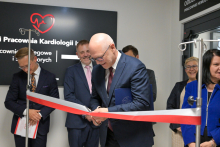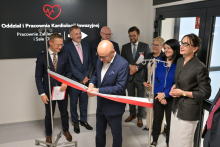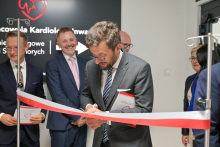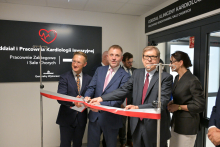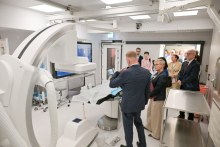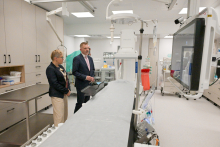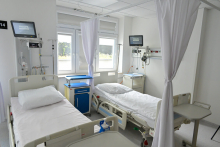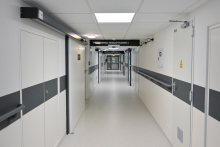The opening of the modernized Invasive Cardiology Department took place on June 27 this year. The ribbon-cutting ceremony was performed by Prof. Maria Mrówczyńska, Undersecretary of State at the Ministry of Science and Higher Education, Katarzyna Kacperczyk, Undersecretary of State at the Ministry of Health, Prof. Rafał Krenke, Rector of WUM, Marzena Kowalczyk, Director of UCC WUM, Filip Nowak, President of the National Health Fund, Prof. Marcin Grabowski, Head of the 1st Chair and Department of Cardiology UCC WUM and Prof. Janusz Kochman, Head of the Department and Hemodynamic Laboratory, Prof. Grzegorz Opolski.
- This is a special moment for the entire department's team - doctors, nurses, technicians and all employees who over the years have been building the position of this center, which meets all the criteria for a Center of Excellence in Cardiology - says Prof. Marcin Grabowski, Head of the Department of Cardiology UCC WUM - Thanks to this investment, we can not only help patients even better, but also develop scientific research and educate new generations of specialists in conditions corresponding to the standards of the best European clinics.
- The new department will allow us to provide the highest quality medical care. Thanks to the use of the latest technology and expanded infrastructure, we can help our patients even more effectively, providing a high level of comfort and safety, when performing even the most complex procedures - says Professor Janusz Kochman, Head of the Hemodynamic Unit and Laboratory - This translates into numerous benefits for patients, including reduced hospitalization time, reduced risk of complications, and faster recovery and return to full function. In critical situations, we can also use modern methods of circulatory support, which increases the safety of therapy.
In addition to those mentioned, the opening ceremony was attended by, among others: Patrycja Gutowska, Deputy Director of the Department of Science at the Ministry of Science and Higher Education; Konrad Korbiński, Director of the Department of Coordinated Care at the Ministry of Health; Dr. Filip Nowak, President of the National Health Fund; Prof. Zdzisław Gajewski, Director of the Center for Translational Medicine at the Warsaw University of Life Sciences; Dr. Michał Hawranek, President of the Association of Cardiovascular Interventions of the Polish Cardiac Society; and from WUM: Prof. Marek Kuch, Vice Rector for Student Affairs and Education, and Prof. Tadeusz Tołłoczko, Former Rector of WUM.
Project combining the idea of modern cardiovascular science with the provision of medical services
The science-related investment, “Expansion of the University Center for Research and Development of Interventional Heart Disease Treatment,” was made possible thanks to an earmarked grant from the Minister of Science and Higher Education, with the support of the MUW rectoral authorities and the hospital management.
- As a strong academic center, we make every effort to have the best possible modern clinical base to serve patients, scientific research and the education of students and doctors. This is one of the strategic tasks included in the WUM Development Strategy for 2025-2028 - stressed Prof. Rafal Krenke, Rector of WUM - The opening of the modernized Ward of Invasive Cardiology of the 1st Chair and Department of Cardiology WUM is a practical example of the realization of such goals. I would like to express my sincere thanks to the Ministry of Science and Higher Education for granting a subsidy for this noble cause, as well as to all those who contributed to the smooth implementation of the investment. We feel great satisfaction and are collectively pleased that, our employees will be able to provide advanced, highly specialized services in such excellent conditions, and students will learn modern cardiology.
- It is a real pleasure to be here with you today. We are very pleased that we were able to subsidize this project - said Maria Mrówczyńska, Undersecretary of State at the Ministry of Science and Higher Education - I wish you that scientific work, the education of students, as well as the provision of services to society in these new interiors will be carried out at the highest level.
University Center for Research and Development of Interventional Heart Disease Treatment - one of the first such centers in Poland
The investment also created a state-of-the-art research and development space that enables innovative, non-commercial research in the field of interventional treatment of heart disease. The University Center for Research and Development of Interventional Heart Disease Treatment, one of the first specialized centers in Poland, will allow:
- Conducting early phase clinical trials and translational research,
- the use of 3D imaging technology,
- fusion imaging and the use of AI-based tools,
- implementing innovative treatment protocols for cardiac patients.
- In addition to the clinical aspects, the scientific value of this project is extremely important to us. With the new infrastructure, we can conduct high-quality research that we hope will contribute to advances in the diagnosis and treatment of heart disease - adds Prof. Grabowski.
Invasive cardiology in the 1st Department of Cardiology UCC WUM
The department is one of Poland's leading centers for invasive cardiology, especially innovative percutaneous interventions for valvular heart disease.
Annually, the Department performs:
- approx. 1,000 percutaneous coronary artery angioplasty procedures (half in acute coronary syndromes),
- 300 TAVI procedures - percutaneous aortic valve implantation,
- 150 mitral and tricuspid valve repair procedures,
- 100 procedures to close the left atrial appendage and other atrial defects (ASD, PFO).
The modernization of the Invasive Cardiology Department opens up new prospects for the development of cardiology at our university. This includes the introduction of innovative diagnostic and therapeutic methods, as well as an increase in the number of procedures and, consequently, improved availability of interventional cardiology procedures. A breakthrough is the full integration of new angiographs with computed tomography (CT) of the coronary arteries and heart, which allows us to perform procedures under CT guidance. Our capacity for scientific and teaching activities is also being expanded.
